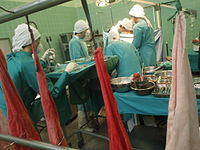
Photo from wikipedia
Background. Persistent ascites after orthotropic liver transplantation has numerous causes and can be challenging to manage. This study aimed to determine the outcomes associated with conservative and endovascular intervention of… Click to show full abstract
Background. Persistent ascites after orthotropic liver transplantation has numerous causes and can be challenging to manage. This study aimed to determine the outcomes associated with conservative and endovascular intervention of posttransplant ascites after deceased donor liver transplantation. Methods. Adult (≥18 y) liver transplant recipients (between 2006 and 2019) who underwent hepatic venous pressure studies to investigate posttransplant ascites were included in this retrospective study. Comparisons were made between those who were managed with conservative therapy versus endovascular intervention and were also based on hepatic venous wedge pressure gradient (normal [≤10 mm Hg] versus elevated [>10 mm Hg]). Results. A total of 30 patients underwent hepatic venography to investigate ascites during the study period. The median time from transplant to venography was 70 d. At least 1 endovascular intervention was performed in 18 of 30 patients (62%), and 12 of 30 patients (38%) were managed conservatively. Endovascular interventions included angioplasty (n = 4), hepatic vein stenting (n = 9), or a transjugular intrahepatic portosystemic shunt (n = 7). The mean (range) hepatic venous wedge pressure gradient for the conservative and endovascular intervention groups was 12 mm Hg (3–23) and14 mm Hg (2–35), respectively. At a 6-mo follow-up, ascites resolved in 6 of 12 patients (50%) and 11 of 18 patients (61%) in the medical management and endovascular groups, respectively. The graft survival rates at 6 and 12 mo were (7/12 [58%] versus 17/18 [94%], P = 0.02) and (7/12 [58%] versus 14/18 [78%], P = 0.25), respectively. Conclusions. Despite medical or endovascular intervention, resolution of ascites is achieved in <60% of patients with persistent ascites. Biopsy findings and venographic pressure studies should be carefully integrated into the management of posttransplant ascites.
Journal Title: Transplantation Direct
Year Published: 2022
Link to full text (if available)
Share on Social Media: Sign Up to like & get
recommendations!